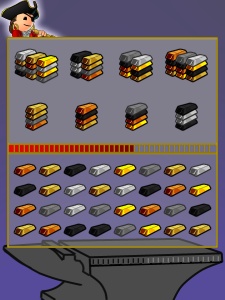GCPP:Proposal-Jutjaw
Puzzle Codename: Jutjaw
| Contact | |
| Username: | Chewie007 |
| Additional contact info: | WalkinCarpet on Sage Ocean |
| Project forum thread: | Discussion |
Game concept
A play off the concept of a rubix cube where the user attempts to create specific stacks of pieces by rotating pieces horizontally and vertically on a single plain. As a piece reaches one side (top, bottom, left or right) it will rotate around and appear on the opposite side. As players complete stacks, they are removed from the playing board and replaced with additional pieces.Objective
Complete a given number of stacks. Similar to the Shipwritery and Alchemy puzzles there should be some sort of meter showing how many you have completed/how close you are to finishing.
Gameplay
The board will be layed out in two sections very similar to the shipwrightery puzzle. The lower section of the board will be a grid of pieces representing various types of metal (steel, copper, iron, brass, etc). above this will be be the area containing the selection of stacks that can be hammered. Between the two sections will lie a countdown bar showing how long they have left to complete a stack. This will represent (metaphorically) the metals cooling and so it will fade from red to black. Beneath the play are will be an anvil with a section of "marks" showing how many stacks have been completed, and how many are left to go before the round is finished.
As a round proceeds, a player can move rows left and right to shift the pieces within each row (wrapping around at the edges). Likewise they can shift columns up and down with pieces wrapping from the top to the bottom or vice versa). Below is an illustration of how this movement would work.
The player will have a limited time to complete at least one stack before they "booch it". A stack is completed by dragging the representation from the top section over the completion in the bottom section, much like it is done in shipwrightery. If they complete a stack, new pieces are dropped in where the used pieces had previously been, a mark is added to the completion marks, and all of the metals are "reheated" (i.e. the countdown timer is reset). When filling in the openings from the used pieces, the puzzle should first make sure that there are enough of each metal type to complete any of the current requested stacks, and then fill the rest with random pieces. The round is over when the player fills up the completion marks on the anvil or if the player booches.
Scoring
Scoring can be managed in a similar fashion to the shipwrightery puzzle in that you can have more complex stacks (involving multiple columns) as well as completing multiple stacks without shifting the puzzle area.
Variability
Any number of stack combinations can be made, though I wouldn't suggest making them more than three columns wide. Also, the height of the stacks could be adjusted. For instance, the lower skill levels could include stacks of two, and as you proceed, you can increase up to 3, 4 or 5. Additionally, special pieces could be placed on the board that are "locked" (unmovable), but add the ability to rotate pieces around them (specifically the 4 pieces directly adjacent to them). The animation below shows how this might work.
End criteria
Completing the given number of stacks.
Difficulty scaling
This can be tied in with the variability and scoring aspects: more layers and more columns makes the solution more difficult/complex. Another addition to the difficulty aspect could be inserting pieces onto the board that are "fused" together and must be moved together. For the best playability, this would probably be limited to fusing two pieces together horizontally or vertically. For a horizontally fused set, if you wanted to move it up and down you would have to move two columns at once. Likewise, for a vertically fused set, if you wanted to move it left and right you would have to move two rows at once. The picture below shows an idea of how this could be represented. The more fused pieces on the board, the more difficult it becomes.
These could also be tweaked a little to allow for "flipping" the fused pieces, where they swap positions. Doing this will help prevent the creation of impossible requests / board layout combinations.
Crafting type
smithing.
Known problems
- This is similar to shipwrightery.
- It seems that it would probably be very difficult to create multiple stacks in a row.
- Hard to represent the requested stacks in an easily readible way.
- Better represents the swordmaking than the cannon ball production, even though CB production will be the primary work.
Notes
Alternatively, if this is too similar to the shipwrightery puzzle, instead of having to complete stacks, the board area could have background colors in sections with the goal being to move all the appropriate pieces of metal into the correct form (which would take up the whole board). This would be a lot closer to a rubix cube as well as making it more different from shipwrightery. Perhaps variability and difficulty could be handled by creating "fused" pieces that must move together.
Images




